Toshiba Chromebook 2: A Feast for the Eyes
by Jarred Walton on February 11, 2015 10:00 AM ESTToshiba Chromebook 2: A Beautiful Display
We’ve talked quite a bit already about the great display in the Toshiba Chromebook 2. Really, it’s the primary reason to buy this laptop over one of the alternatives, and as such it’s the best place to start our objective benchmarks. For these tests, we can’t create a color profile so what you get in the box is what you’re going to have to live with, meaning display quality becomes even a bit more important. On the other hand, it’s also important to remember that having really accurate colors is mostly a concern for imaging/video professionals or A/V enthusiasts, and you could certainly argue that neither group is really looking to use a Chromebook. For most users, the most compelling aspect is going to be the LCD viewing angles, as it means you don’t have to be positioned perfectly to get a legible screen:
TN panels always have problems with vertical viewing angles, which makes them a particularly bad choice on laptops as you’re frequently looking at the screen from slightly above rather than straight on. Over the years, at least that aspect has improved slightly, but it’s still clearly inferior to the experience that an IPS panel can offer – and don’t even get me started on the “from below” angles on TN, though that’s usually less of a concern. The Toshiba Chromebook 2 1080p display has no problems, regardless of viewing angle, and you reach the point where the angle is far too oblique to be useful before you have any issues with color shifting. Let’s move on to the color accuracy figures.
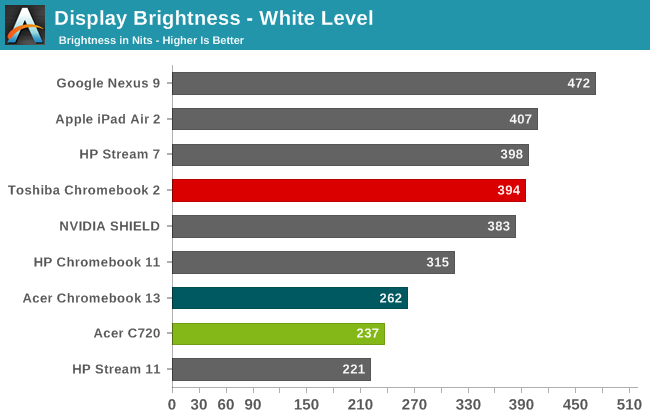
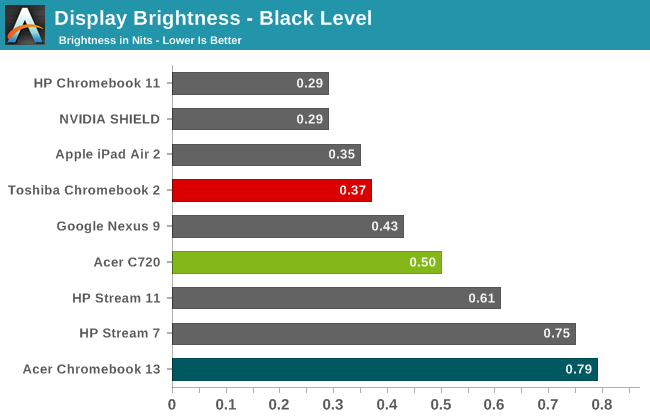
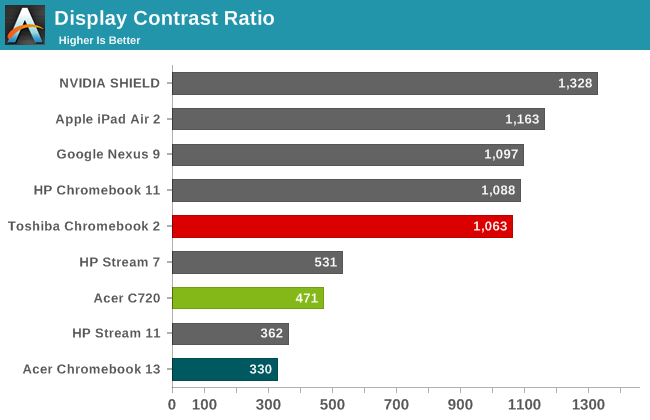
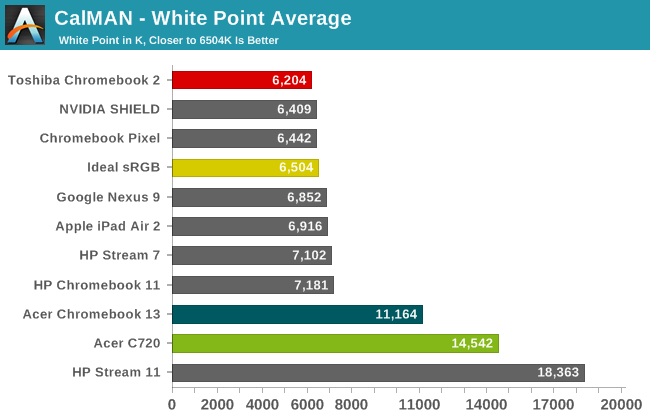
The maximum brightness of nearly 400 nits is great to see, as it makes this laptop useable even in outdoor environments, though reflections from the glossy display can still be a problem. The black levels at maximum brightness are 0.371 as well, which while not perfectly black are still closer than what you’ll see on most other laptops. Combined, we end up with a contrast ratio of 1063:1, though I should note that contrast improved at 200 nits to 1291:1 thanks to a proportionally better black level. The white point is also quite good, coming closer to the desired 6504K than any other Chromebook we’ve tested so far.
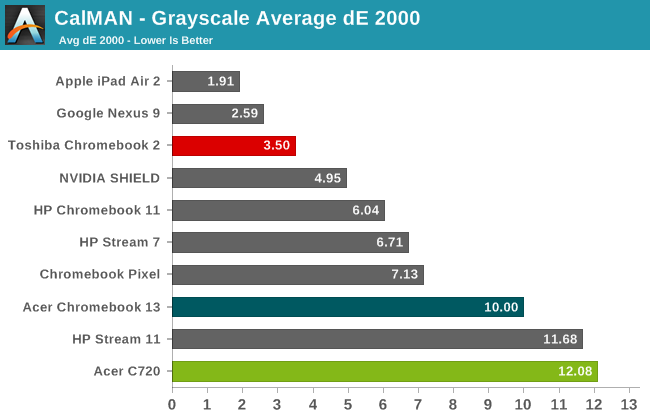

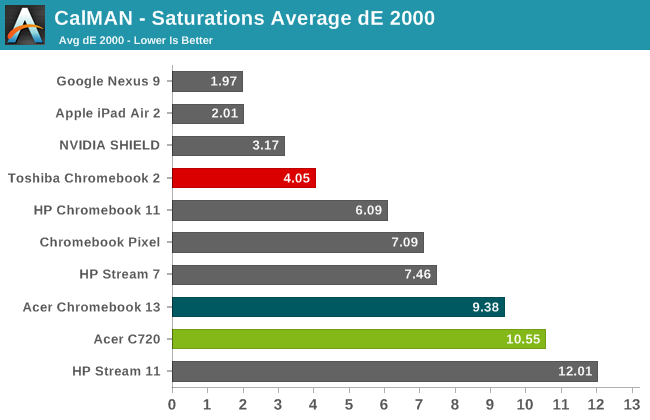
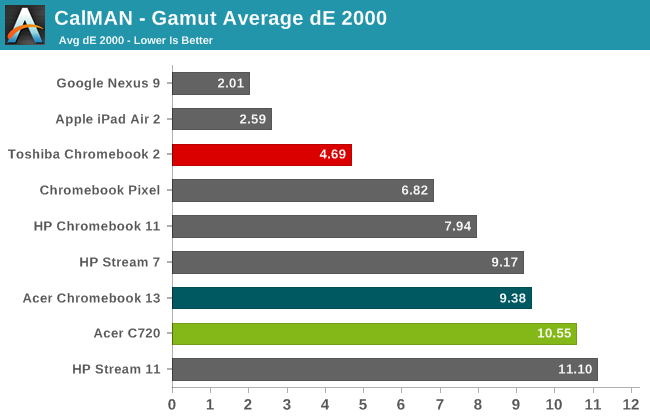
Delta E values could still be improved, but it has to be said that the Toshiba display still rates far better than the vast majority of Windows laptops we’ve tested. There are definitely colors that miss the mark, but in most of our tests the average Delta E ends up being around 4.0, which is higher than the desired average of 3.0 but quite a bit lower than the point where inaccuracies start to become distracting (6.0). The only displays we’ve tested in the above charts that do better overall are on the Nexus 9 and iPad Air tablets, and those are the two best tablet displays we’ve tested. When you look at the results of the other Chromebooks (including the Pixel), Toshiba really stands out from the crowd of mediocre color quality.
If you want more details on the display, the above gallery contains additional charts for our LCD quality testing. Color gamut is basically equal to sRGB, which is what most people would want on an Internet-centric device. Basically, it's a really good display, and exceptional to find such quality on a $300 laptop. I just wish we could get any Windows laptop for under $750 with something close to this level of quality. For all of those who comment that they “stopped reading after seeing how bad the display was”, at least this time there’s nothing to complain about. I still wish this sort of performance was more of the norm rather than the exception, and perhaps we’ll get there over the coming years, but regardless it’s a nice change of pace – and all the more refreshing to see on a $329 device.





















66 Comments
View All Comments
gd22 - Wednesday, February 11, 2015 - link
Dinosaurs need to carry big hard drives, ultrabooks don't. I've had the Samsung 303c for 2 years plus, and never had a problem about the size of the drive. Maybe 15 to 20 times in those 2 years I've "increased" the size of the memory by using SD Cards.The video editing knock isn't fair to the Chromebook. If you need professional Adobe editing, then you need a MacBook and $600 Adobe software. For screencasting, and simple video like trimming the start and stop of a video, or a cut and paste, the Chromebook gets the job done, but it ain't great.
What Chromebook doesn't have is an easy way to use it as a developer. Installing Meteor, AngularJS, Ruby, basically can't be done, and have the Chromebook still be a Chromebook. For those with advanced skilz, it does have a nice SSH terminal for reaching your server.
Tin Weasel - Thursday, May 28, 2015 - link
I know I'm adding to a dead thread here, but I just set up a Dev environment on my chromebook using cloud9 online IDE, and it's working very well for me. You get a very functional code editor in a browser, and full terminal access to a VM on their end, set up for whatever you're doing. I haven't come across any major limitations yet, but I'm just getting into it. Check it out if you haven't already.jabber - Wednesday, February 11, 2015 - link
I love Chromebooks and think they are the way ahead for many. However, they have one big issue that stops me recommending them to the very people they are often aimed at.Printing.
It's still a mess. I hate printing but so many others live by the ability and Chromebooks still don't have a simple easy way to print. I have a Chromebook enabled printer and it's still hit and miss.
jabber - Wednesday, February 11, 2015 - link
As for my next Chromebook, I'd settle for a 11" 1600x900 IPS one.gd22 - Wednesday, February 11, 2015 - link
Yes. I also pro Chromebooks, but agree that printing experience is still a mess.aryonoco - Wednesday, February 11, 2015 - link
Great review Jarred, thanks for taking the time to review this machine.Just one thing I would like to add regarding your mention of the "walled garden" experience of Chromebooks. While on the face of it true, I think it's important to point out a huge caveat: Chromebooks have an official way to be rooted, it's easy to do that, requires no hacking or jailbreaking, and doesn't void the warranty. Once rooted, obviously the walled garden falls and you are in full control and can run anything you want, including an alternate Linux distro. As a bonus: you can even restore it back to a non-rooted "secure" state with no effort.
Plenty of people, power users in general, like to have full control of the machines that they "own". This is why a lot of us are hugely dismayed by Apple's walled garden approach and their quest against jailbreaking, or by many Android manufacturers who make it very difficult to root devices. Chromebooks offer the best of both worlds: a walled garden for the average user to keep them protected from the nasties, and the ability to fully own the system for those who demand such freedom.
derder1 - Wednesday, February 11, 2015 - link
About time, Anandtech! I've been waiting a review for since like Nov/Dec 2014! By the way what is RGB % that this display show?AnnonymousCoward - Thursday, February 12, 2015 - link
"sRGB" - about 72% I think.JarredWalton - Thursday, February 12, 2015 - link
Yeah, it's pretty close to full sRGB gamut, though I'm not sure how to get gamut in this case. (Normally, I get gamut from Windows laptops using the ICM file, but there's no way I know of to create an ICM for a Chromebook. I'm sure there's some way to still get gamut somewhere in CalMAN, but I admit that software is not my forte.)AgeOfPanic - Thursday, February 12, 2015 - link
I recently bought an Asus C200 chromebook. While it has some redeeming features, namely build quality and especially battery life, it is too slow in daily use. I understand that for the money you should expect some issues, but I find myself waiting on everything. Page loading, open Chrome apps and everything. It has a 2830 processor compared to the 2840 in this one, but then again the Toshiba got a higher resolution screen.I would be very hesistant to buy another Chromebook with such a slow processor. Chromebooks themselves are awesome though.